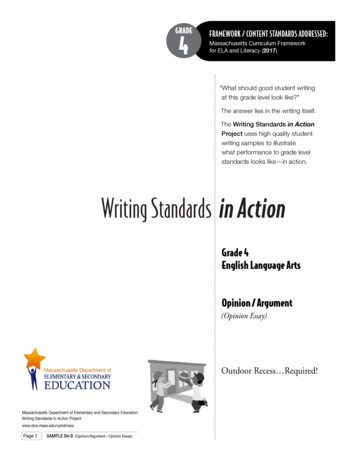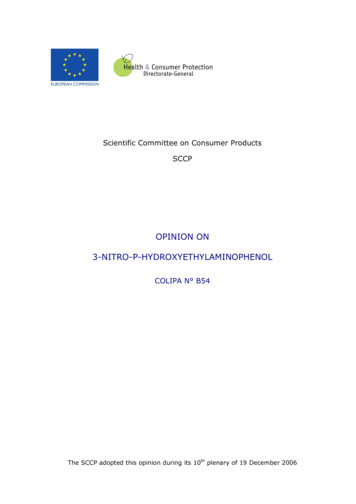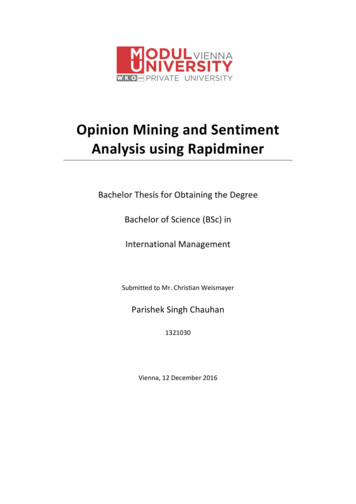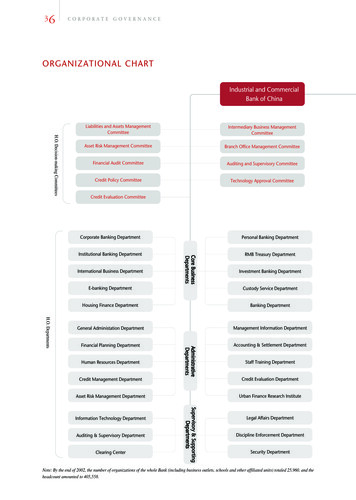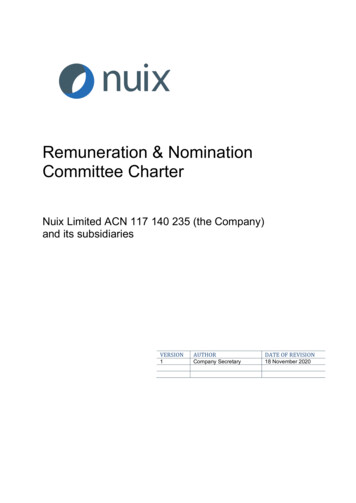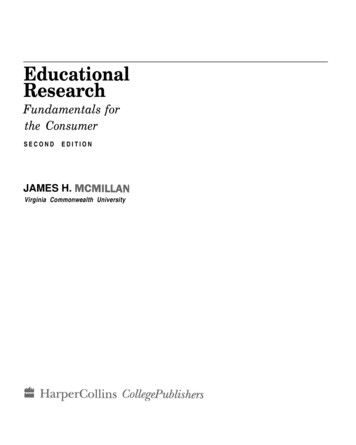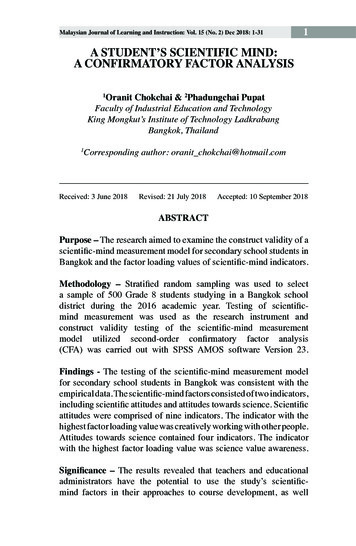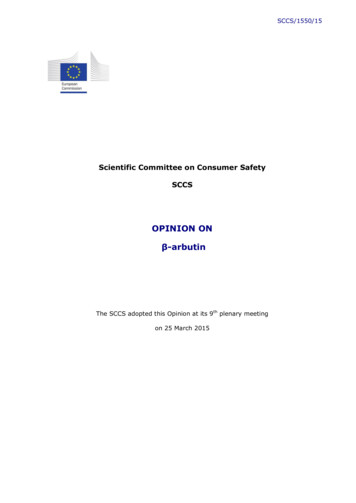
Transcription
SCCS/1550/15Version SScientific Committee on Consumer SafetySCCSOPINION ONβ-arbutinThe SCCS adopted this Opinion at its 9th plenary meetingon 25 March 2015
SCCS/1550/15Opinion on β-arbutinAbout the Scientific CommitteesThree independent non-food Scientific Committees provide the Commission with thescientific advice it needs when preparing policy and proposals relating to consumer safety,public health and the environment. The Committees also draw the Commission's attentionto the new or emerging problems which may pose an actual or potential threat.They are: the Scientific Committee on Consumer Safety (SCCS), the Scientific Committeeon Health and Environmental Risks (SCHER) and the Scientific Committee on Emerging andNewly Identified Health Risks (SCENIHR) and are made up of external experts.In addition, the Commission relies upon the work of the European Food Safety Authority(EFSA), the European Medicines Agency (EMA), the European Centre for Disease preventionand Control (ECDC) and the European Chemicals Agency (ECHA).SCCSThe Committee shall provide opinions on questions concerning all types of health and safetyrisks (notably chemical, biological, mechanical and other physical risks) of non-foodconsumer products (for example: cosmetic products and their ingredients, toys, textiles,clothing, personal care and household products such as detergents, etc.) and services (forexample: tattooing, artificial sun tanning, etc.).Scientific Committee membersUlrike Bernauer, Qasim Chaudhry, Pieter Coenraads, Gisela Degen, Maria Dusinska, WernerLilienblum, Elsa Nielsen, Thomas Platzek, Suresh Chandra Rastogi, Christophe Rousselle,Jan van Benthem.ContactEuropean CommissionHealth & Food safetyDirectorate C: Public HealthUnit C2 – Health Information/ Secretariat of the Scientific CommitteeOffice: HTC 03/073L-2920 LuxembourgSANTE-C2-SCCS@ec.europa.eu European Union, 2015ISSN 1831-4767ISBN NThe opinions of the Scientific Committees present the views of the independent scientistswho are members of the committees. They do not necessarily reflect the views of theEuropean Commission. The opinions are published by the European Commission in theiroriginal language only.http://ec.europa.eu/health/scientific committees/consumer safety/index en.htm2
SCCS/1550/15Opinion on β-arbutinACKNOWLEDGMENTSSCCS MembersDr. U. BernauerProf. P.J. CoenraadsProf. G. DegenDr. M. DusinskaDr. W. LilienblumDr. E. NielsenProf. T. PlatzekDr. S. Ch. RastogiDr. Ch. RousselleDr. J. van Benthem(rapporteur)(chairman)Former SCCS MemberProf. A. LuchExternal expertsProf. A. BernardProf. A.M. Giménez-ArnauProf. T. VanhaeckeKeywords: SCCS, scientific opinion, β-arbutin, Regulation 1223/2009, CAS:EC: 207-850-3497-76-7,Opinion to be cited as: SCCS (Scientific Committee on Consumer Safety), Opinion on βarbutin, SCCS/1550/15, 25 March 20153
SCCS/1550/15Opinion on β-arbutinTABLE OF CONTENTS1.BACKGROUND . 62.TERMS OF REFERENCE. 63.OPINION . 73.1Chemical and Physical Specifications. unction3.3Chemical identity . 7Physical form . 8Molecular weight . 8Purity, composition and substance codes . 8Impurities / accompanying contaminants . 9Solubility . 9Partition coefficient (Log Pow) . 9Additional physical and chemical specifications . 9Homogeneity and Stability . 10and uses . 14Toxicological Evaluation . 144.3.3.1Acute toxicity . 143.3.2Irritation and corrosivity . 163.3.3Skin sensitisation . 173.3.4Dermal / percutaneous absorption. 183.3.5Repeated dose toxicity . 233.3.6Mutagenicity / Genotoxicity . 253.3.7Carcinogenicity . 273.3.8Reproductive toxicity . 283.3.9Toxicokinetics . 303.3.10Photo-induced toxicity . 303.3.11Human data . 323.3.12Special investigations . 363.3.13Safety evaluation (including calculation of the MoS) . 363.3.14Discussion . 37CONCLUSION . 445.MINORITY OPINION. 456.REFERENCES . 454
SCCS/1550/15Opinion on β-arbutin1. BACKGROUNDSubmission I for β-Arbutin (CAS 497-76-7) with the chemical name 4-hydroxy-phenyl-β-Dglucopyranoside and the INCI name Arbutin was submitted in July 2005 by COLIPA1.The effect of Arbutin seems to be due to the fact that it hydrolyses to Hydroquinone.However, Hydroquinone (CAS 123-31-9) is listed in Annex II/1339 of the CosmeticRegulation No 1223/2009; it means it is banned as cosmetic ingredient with the exception ofentry 14 in Annex III. Its permitted use is restricted to professional use in artificial nailsystems in a concentration in the final product up to 0.02%. Since Hydroquinone could notbe used as a skin whitener after introduction of a ban, other substances have been used forthat purpose, including Arbutin.The first opinion (SCCP/1158/08) on beta-arbutin was adopted the 15 April 2008 with theconclusion: "Although the general toxicological assessment of β-arbutin suggests that thesubstance may be safe, the bioavailability of hydroquinone under conditions of intended useof the substance is of concern. Whereas hydroquinone was initially permitted at aconcentration of 2%, a 1998 opinion of the SCCNFP recommended that the substanceshould not be used any more as a depigmentating agent in cosmetic products due toobserved clinical side effects, among which exogenous ochronosis [41].Consequently, the SCCP considers the currently requested use of β-arbutin in cosmeticproducts unsafe. In addition, it is the opinion of the SCCP that the same concern can beexpressed for other products that result in the release and/or formation of hydroquinonebefore or upon application on the skin."The substance is used as a chemical ingredient alone and as a component of plant extractslike Arctostaphylos Uva Ursi, Vaccinium Vitis-Idaea, Chimaphila Umbellata etc, all rich incontent of arbutin, according to the information on skin lightening products available to theCommission Services.The current submission II is a response to the first opinion on beta-Arbutin.2. TERMS OF REFERENCE(1)Does the SCCS consider on the basis of the provided scientific data, the use of β-arbutinto be safe for consumers in cosmetic products in a concentration up to 7% in facecreams?(2)Does the SCCS have any further scientific concerns with regard to the use of β-arbutin incosmetic products?1COLIPA – The European Cosmetics Association, now Cosmetics Europe5
SCCS/1550/15Opinion on β-arbutin3. OPINIONThe previous SCCP 2008 Opinion (SCCP/1158/08) was based on Submission I of theapplicant (Shiseido via COLIPA) from July 2005. The present Opinion also includesSubmission II from May 2009 and information provided thereafter (Cover Letter Shiseido toEU COM of April 2012 with “Final Expert statement SCCS Arbutin requests KS 26-04-2012”)3.1Chemical and Physical Specifications3.1.1Chemical identity3.1.1.1 Primary name and/or INCI nameArbutin (INCI name)Ref.: 8, 9, 153.1.1.2 Chemical names4-Hydroxyphenyl- -D-GlucopyranosideRef.: 8, 9, 153.1.1.3 Trade names and abbreviationsArbutinRef.: 8, 9, 153.1.1.4 CAS / EC numberCAS: 497-76-7EC: 207-850-3Ref.: 93.1.1.5 Structural formulaOHHOH2COHOHOOOHRef: Schindler et al. 20023.1.1.6 Empirical formulaC12H16O73.1.2Physical formWhite to light grey powderRef.: Appendix 1 in Submission I6
SCCS/1550/15Opinion on β-arbutin3.1.3Molecular weight272.25 g/molRef.: 8, 9, 153.1.4Purity, composition and substance codesPurity: 97.0 β -arbutin:Lot A:Lot B:Lot C:Batches used:102.0 %99.7%97.8%99.8%LotLotLotLotTDA-361: 100.3%TDD-422: 100.0%TPG-412: 99.8%TGJ-225: 100.4%Ref.: Appendix 1 in Submission ILot A, B, C:Lot A:stability testingacute oral and dermal toxicity testskin and eye irritation in the rabbitskin sensitisation assay28 day oral & 90 day dermal toxicity testmutagenicity testing1-generation reproduction toxicity testphototoxicity & photosensitisation assayhuman patch testLot TDD-422: carcinogenicity studyLot TPG-412: human skin metabolism (repeated topical application) Lot TDA-361: human (patch) tests with 7-10% β -arbutin formulations 3.1.5Impurities / accompanying contaminantsHydroquinone:Chloride:Heavy metals:Arsenic:Iron:3.1.6 0.030%:Lot A: 0.0129%Lot B: 0.0208%Lot C: 0.0094% 0.036%20 ppm2 ppm20 ppmLotLotLotLotTDA-361: 0.0064%TDD-422: 0.0033%TPG-412: 0.0019%TGJ-225: 0.0043%Ref.: Appendix 1 in Submission ISolubilityWater, propylene glycol:Ethanol, glycerine:Squalane, olive oil: 10g/100g1-10g/100g 1g/100gRef.: 15CommentThe water solubility has not been measured by the EC method A.67
SCCS/1550/15Opinion on β-arbutin3.1.7Partition coefficient (Log Pow)- 1.35 (probably calculated, no details given).Ref.: 8CommentThe Log Pow has not been determined by the EC method A.8.3.1.8Additional physical and chemical specificationsUV light absorption spectrum:Melting point:pH:Specific rotation:(method notspecified)3.1.9spectrum not available max 285 nm (in summary report) 197-201 C:Lot A: 198.3 C Lot TDA-361: 201.2 CLot B: 198.0 C Lot TDD-422: 200.0 CLot C: 198.7 C Lot TPG-412: 201.0 CLot TGJ-225: 201.0 C5-7:Lot A: 5.78Lot TDA-361: 6.00Lot B: 5.63Lot TDD-422: 6.10Lot C: 5.75Lot TPG-412: 6.10Lot TGJ-225: 6.10[ ]D25 -62 to -68 :Lot A: -64.2Lot TDA-361: -65.8Lot B: -66.1Lot TDD-422: -65.7Lot C: -64.8Lot TPG-412: -65.0Lot TGJ-225: -65.4Homogeneity and Stability3.1.9.1 Stability of β-arbutin as a raw materialData from submission IIPhotostability test in aqueous solution (Test of 2006)Sample preparation: Concentration of β-Arbutin (Lot TQI-771, TQI-772, TQI-773) were 3%and 6.3%; dissolved in 10% ethanol and waterLight Source - a white fluorescent lamp and near ultraviolet lampProcedure - Samples were kept in transparent glass bottle of 50mL. Protected sampleswrapped in aluminium foil were used as controls. Samples were exposed to light providingan overall illumination of no less than 1.2 million lux hours and an integrated nearultraviolet energy of no less than 200 w·h/m2 at 25οC then measured instantly in compliancewith ICH guidelines, the analysis being repeated 3 times for each lot of product, using anHPLC assay with detection at 280 nm.Test results are provided in the Summary Table below.The quantitation limit of hydroquinone (HQ) in the samples was 1 ppm.8
SCCS/1550/15Opinion on β-arbutinConclusionThe photostability of β-arbutin (3% and 6.3% solutions) was investigated in 10% ethanoland pure water. Following the ICH guideline for the photostability testing, the solutions wereexposed to light providing an overall illumination of no less than 1.2 million lux hours andan integrated near-ultraviolet energy of no less than 200 w・h/m2 at 25 C. No apparentchange in the amount of β-arbutin was observed between light-exposed and controlsamples. A slight increase of hydroquinone, on the other hand, was observed in lightexposed 6.3% solutions although those levels were always below 2.5 ppm after lightexposure.Ref. 1 in subm IIPhotostability at different pH values and temperatures (Test date 2008-9)Sample type: 7% β-arbutin in phosphate buffers ranging from pH 2.0-11.0Samples prepared from Lot TTG-305 were subdivided and kept in transparent glass bottles(30ml). Protected samples wrapped in aluminium foil were used as dark controls. Sampleswere exposed to light (white fluorescent lamp) providing an overall illumination of no lessthan 1.2 million lux hours and an integrated near ultraviolet energy of no less than 200 w・h/m2 at 25ο (ICH guidelines). The effects of temperature were studied at 50οC for 1 monthand 40οC for 3 months. The analyses were repeated 3 times for each lot of product.Results (for pH of solutions, parent compound and hydroquinone content) at variousconditions are summarised below:9
SCCS/1550/15Opinion on β-arbutin* The quantitation limit of HQ in these samples was 1 ppm.The authors concluded that for both the heat and light conditions, no apparent change onthe amount of β-arbutin was observed at pH 4-11. β-Arbutin levels were slightly decreasedat pH 3 accompanied by a rapid increase of hydroquinone. The degree of hydroquinonegeneration was higher at low pH ( 4,300ppm at 50 C 1 month and 3,700ppm at 40 C 3months at pH 2); however only trace levels of hydroquinone were detected in neutral tobasic solutions (pH 6-11).Ref. 2 in subm II3.1.9.2 Stability of β-arbutin in a cosmetic formulationData from subm IIA. β-arbutin in a finished cosmetic product (accelerated test conditions for 6 months)Date of study:Method:Test substance:Temperature:Relative HumidityAnalytical method:2008-2009Internal protocol Shiseido Co, Japan.Shiseido Product C (Lot 0804A, B, C) containing5.67-6.93% β-arbutin at pH 5.0-7.040οC75%HPLC10
SCCS/1550/15Opinion on β-arbutinSamples were kept in a transparent glass bottle at 40 C and 75% relative humidity for6 months. β-Arbutin and hydroquinone concentrations were measured in threefold by HPLCfor each batch at the start of the study, after 3 months and after 6 months.Results (for pH, parent compound and hydroquinone) at various conditions are summarisedbelow:ConclusionsSince the concentrations of β-arbutin were stable and those of hydroquinone remainedbelow 1 ppm (detection limit), the study authors conclude that β-arbutin is stable in finalcosmetic formulations and that no hydroquinone is released under accelerated ageingconditions for 6 months.Ref.: 20 Ref. 3 in subm IIB. β-arbutin in a finished cosmetic product (ambient test conditions for 36 months, i.e.,long-term testing)Date of study:Method:Test substance:Temperature:Relative Humidity:Analytical method:2003-6Internal protocol Shiseido Co, Japan.Shiseido Product C (lot A, B, C) containing 5.67-6.93% β-arbutin (pH5.0-7.0),25οC60%HPLCSamples of Shiseido Product C were kept in a transparent glass bottle at ambient conditionsfor 3 years. β-Arbutin and hydroquinone concentrations were measured in threefold byHPLC at the start and at the end of the study.11
SCCS/1550/15Opinion on β-arbutinResultsSince the concentrations of β-arbutin were stable and those of hydroquinone remainedbelow 1 ppm (detection limit), the study authors conclude that β-arbutin is stable in theusual cosmetic formulation and that no hydroquinone is released under normal storageconditions for 3 years.Ref.: 20-1 Ref. 3 in subm IIOverall conclusions (applicant)β-arbutin was relatively stable to light when dissolved in a 10% ethanol aqueous solution.No significant change in the amount of β-arbutin was detected and only trace levels ofhydroquinone ( 0.25 ppm) were detected under the conditions of the ICH photostabilitytest. β-arbutin was found to be unstable in low pH solutions, decrease of β-arbutin andsignificant increase of hydroquinone was observed, especially at pH 2.On the other hand, β-arbutin was stable in the finished product: hydroquinone content inthe finished product was no more than 1 ppm (LLOQ) throughout the accelerated and longterm storage conditions (40 C, 75% relative humidity for 6 months and (25 C, 60% relativehumidity for 36 months).A recently published study tested ß-Arbutin (and deoxy-arbutin) at 10-4 M ( 0.003 % w/v)in aqueous solution with 10% propylene glycol and UV irradiation (narrow band UVB lightunit at 312 nm) at 2.65 mW/cm2: under these conditions (pH not given), ß-arbutin wasreduced to 43.5% of the initial level after 2 h of irradiation, and hydroquinone was detectedat significant levels (up to 20%) over the test period (up to 12 h).Add. Ref.: Yang CH et al. 2013SCCS remarkAs the test concentration is far below that used in cosmetic products, this study isconsidered to be of limited relevance.SCCS commentThe results presented in the respective studies regarding photostability testing (according toICH guideline) and pH- or temperature-dependent stabilities of β-arbutin sound conclusiveand reliable. In cosmetic formulations hydroquinone as impurity remained below 1 ppm(detection limit). Yet, aside from reduced photostability under certain UV irradiationconditions (Yang et al. 2013), it is to be considered that β-arbutin may also undergocutaneous hydrolysis into hydroquinone due to enzymatic activity through β-glucosidases inskin (Mier & van den Hurk 1976; Redoules et al. 2005) or via the activity of microbesresiding on the surface of the skin (Bang et al. 2008). This is further discussed in section3.3.4.2.12
SCCS/1550/15Opinion on β-arbutin3.2Function and usesThe naturally occurring compound β-arbutin -β-glucopyranoside, CAS 497-76-7) is a β-D-glucopyranoside derivative ofhydroquinone that can be found in the leaves and bark of many plants. It has beenproposed for use as a skin-lightening agent, inhibiting production of the skin pigmentmelanin which is formed through a series of oxidative reactions involving the amino acidtyrosine and the enzyme tyrosinase. This enzyme catalyses the hydroxylation of tyrosine toL-DOPA (dihydroxyphenylalanine) and the oxidation of DOPA to dopaquinone which is thenfurther metabolised to melanin. β-Arbutin is thought to act by inhibition of the activity ofmelanosomal tyrosinase, where the inhibition may be due to structural similarities to thesubstrate tyrosine (Zhu and Gao, 2008). β-Arbutin can be hydrolysed both in acid solutionand by enzymic action to hydroquinone which also acts as a skin lightening agent, again byinhibiting tyrosinase. Extended use of 2% hydroquinone, topically applied, has beenassociated with adverse effects including exogenous ochronosis in dark-skinned people [27,38]. Hydroquinone, like β-arbutin, is present in many dietary components in trace amountsand is metabolised in vivo to its glucuronide and sulphate conjugates.β-Arbutin is proposed to be used as a skin-lightening agent in cosmetic face creams or facelotions at concentrations up to 7%.3.3Toxicological Evaluation3.3.1Acute toxicityFrom SCCP/1158/08 with minor corrections3.3.1.1 Acute oral toxicityGuideline:Date of test:Species/strain:Group size:Test substance:Batch:Purity:Dosages:Observation period:GLP/QAU:OECD TG 401 (1981)3-17 December 1985Sprague Dawley (Crj:CD, SPF) rats and ICR (Crj:CD-1, SPF) mice5 rats or mice/sex/doseβ-arbutinLot A99.7%1792, 2509, 3513, 4919, 6886, 9641, 13496, 18895 mg/kg bw14 days/The test substance was applied by oral gavage at dosages of 1792, 2509, 3513, 4919,6886, 9641, 13496, 18895 mg/kg bw to groups of 5 male and/or 5 female rats and mice.The animals were checked daily for mortality and clinical signs. Body weights were recordedon days 1 to 5, 7, 8, 11 and 15. Animals were observed for 14 days. Animals that diedduring the test and all surviving animals at the end of the observation period weresubmitted to gross necropsy.ResultsLethality is summarised in the following table:Dosage(mg/kg bw)17922509Lethalitymale rats0/50/5Lethalityfemale rats0/50/513Lethalitymale mice0/50/5Lethalityfemale mice0/50/5
SCCS/1550/15Opinion on 3/53/55/5* one of the five 6886 mg/kg bw male mice died by gavage accidentLiver changes associated with the test substance were observed at 4149 mg/kg bw in miceand at 9641 mg/kg bw in rats, though not at lower dosage levels.There were no deaths in mice given 3513 mg/kg bw or in rats given 4919 mg/kg bw.Few toxic signs were observed in either species at dosage levels up to 3513 mg/kg bw.ConclusionThe study authors conclude that the oral LD50-value for β-arbutin is 9804 mg/kg bw for themouse and 8715 mg/kg bw for the rat. These values indicate a low level of acute oraltoxicity.Ref.: 13.3.1.2 Acute dermal toxicityGuideline:Date of test:Species/strain:Group size:Test substance:Batch:Purity:Dosages:Observation period:GLP/QAU:OECD TG 402 (1981)January-April 1986Sprague Dawley (Crj:CD, SPF) rats and ICR (Crj:CD-1, SPF) mice10 rats or mice/sexβ-arbutin, 30% (w/w) in a 50:50 ethanol:water solution Lot A99.7%928 mg/kg bw (technically applicable maximal dosage)14 days/For both rats and mice, the test substance was applied evenly on the back after fur clipping(treatment area not mentioned). The applied volume was 3 ml/kg, the maximum technicallyachieved. 30% β-arbutin in 50% ethanol aqueous solution led to a dosage of 928 mg β-arbutin/kg bw.For mice, clinical signs were recorded for 14 days except for holidays, and body weight wasmeasured on day 1 to 3, 5 to 8, 12 and 15. For rats, clinical signs were recorded for 14days, and body weight was measured on day 1 to 3, 5 to 8 and 15. Since no animal diedduring the observation period, all animals were sacrificed with chloroform at the end theobservation period and subjected to necropsy.ResultsNo lethality occurred during the test and no abnormalities in clinical signs were seen. Bodyweight gain was normal throughout the observation period. There were no remarkablefindings at necropsy for either mice or rats.ConclusionFor rats and mice, the LD50 value via the dermal route showed to be greater than928 mg/kg bw (the technically applicable maximal dose).Ref.: 2SCCS commentThe SCCS noted that there is no justification in relation to the ‘the maximum technicallyfeasible’ dose volume of 3 ml/kg (recalculated to a dose of 928 mg/kg bw. According toOECD TG 402 (Acute dermal toxicity) a dose level of 2000 mg/kg is the cut-off for the limittest.14
SCCS/1550/15Opinion on β-arbutin3.3.1.3 Acute inhalation toxicityNo data submitted3.3.2Irritation and corrosivityFrom SCCP/1158/08 (with minor modifications)3.3.2.1 Skin irritationGuideline:Date of test:Species/strain:Group size:Test substance:Batch:Purity:Dosages:Observation period:GLP/QAU:Draize method (1959), no official guidelineApril 1986Japanese white rabbits6 malesβ-arbutin, dissolved as a 10% (w/w) solution in distilled water Lot A99.7%300 µl of the 10% solution was applied on patch of 4.9 cm²72 hoursbefore introduction of GLP (1987), thus not applicable.A 4.9 cm² (2.5 cm diameter) patch test plaster with 300 µl test material (10% β-arbutin indistilled water) was placed on shaved intact and abraded (by needle scratching not deepenough to cause bleeding) dorsal skin sections of six male rabbits for 24 hours. After the24-hour application time, the patch was removed. No rinsing was done. Skin reactions wereevaluated for erythema and oedema after 48 and 72 hours.ResultsSlight erythema (score 1) was observed in one rabbit after 24 and 72 hours on intact andabraded skin. No oedema was observed during the test period.ConclusionThe study authors conclude that a 10% aqueous solution of β-arbutin can be considered ashaving ‘little primary irritation potential’.Ref.: 3SCCS commentA 10% aqueous solution of β-arbutin was slightly irritating to the skin.3.3.2.2 Mucous membrane irritation / Eye irritationGuideline:Date of test:Species/strain:Group size:Test substance:Batch:Purity:Dosages:Observation period:GLP/QAU:Internal protocol performing laboratory (Japan), no official guidelineMarch-April 1986Japanese white rabbits3 males -arbutin, dissolved as a 10% (w/w) solution in water Lot A99.7%100 µl of the 10% solution72 hours/15
SCCS/1550/15Opinion on β-arbutin100 µl of test substance (10% -arbutin in distilled water) was instilled to the right eye ofthree rabbits. The eyes were left unrinsed and the untreated left eyes served as control.Ocular reactions were measured for one week according to the Draize method. Readingtimes were at 1, 4, and 24 hours, 2, 3, 6, and 7 days after instillation. Parameters checkedincluded cornea (opacity, area of cornea involved), iris (morbidity value) and conjunctiva(redness, chemosis, discharge).ResultsNo reactions were observed in the cornea, iris or conjunctiva during the test period on anyanimal treated with test substance.ConclusionUnder the conditions of the study, a 10% aqueous solution of -arbutin was not irritating tothe rabbit eye.3.3.3Skin sensitisationTaken from SCCP/1158/08 (with minor modifications)Guideline:Date of test:Species/strain:Group size:Test substance:Batch:Purity:Dosages:Observation period:GLP/QAU:Magnusson Kligman Guinea Pig Maximisation Test (1970)May-June 1986Hartley albino guinea pig10 females treated with -arbutin10 females treated with hydroquinone5 females treated with positive control (DNCB)10 females treated with distilled water (control group) -arbutin, dissolved as a 10% (w/w) solution in water Lot A99.7%dermal induction: -arbutin10% in water:ethanolhydroquinone: 5% in water:ethanolDNCB:0.1% in liquid paraffindermal challenge: -arbutin1, 3, 10% inwater:ethanolhydroquinone: 1, 3, 10% in water:ethanolDNCB:0.001%, 0.1% in acetone72 hours/On the first day, three samples were intradermally injected on the upper dorsal region:1) 0.1 ml of Freund’s complete adjuvant (FCA):water (1:1)2) 0.1 ml of 10% - Arbutin in distilled water3) 0.1 ml of 10% -arbutin emulsified in FCAOne week after the injections, 50 mg of 10% sodium lauryl sulfate in petrolatum wasapplied to the upper dorsal region. On the next day, 0.2 ml of 10% -arbutin wasocclusively applied for 48 hours. Distilled water was used as negative control, 5% HQ wasused as reference control, and 0.2% 2,4-dinitrochlorobenzene (DNCB) was used as positivecontrol.Three weeks after the first induction, 0.01 ml of 10, 3, and 1% -arbutin in aqueous/ethanol(50/50) solution were topically applied on the flank of animals. 0.01 ml of 10, 3, and 1% HQin aqueous/ethanol (50/50) solution were applied as reference control, and 0.01 mL of 0.01and 0.1% DNCB in acetone were applied as positive control. The reaction was evaluated 24and 48 hours after challenge application.16
SCCS/1550/15Opinion on β-arbutinResultsNo positive reactions were observed at any reading time in animals in either the treated orcontrol groups challenged with 10, 3, or 1% -arbutin in aqueous/ethanol (50/50) solution.All the animals challenged with 3 or 10% hydroquinone and 9 of 10 tested with 1%hydroquinone showed allergic reactions on challenge. Five out of five guinea pigs sensitisedto DCNB showed an allergic reaction when challenged with 0.01 and 0.1% DNCB. Nopositive reactions were observed with the control group at any challenge concentration.ConclusionThe study authors conclude that -arbutin does not possess skin sensitising potential underthe test conditions.Ref.: 7SCCS commentApparently no preliminary study for induction and challenge concentration determinationhas been performed. Challenge with 3 different concentrations is unusual. The scores afterinduction are not stated, thus the adequacy of the concentrations used cannot be checked.The question can be raised whether an aqueous/ethanol (50/50) solution is an appropriatesolvent. An aqueous solution with slightly acidic pH would be more suitable.3.3.4Dermal / percutaneous absorption3.3.4.1 In vitro dermal / percutaneous absorptionGuideline:Date of test:Test system:N of samples:Receptor fluid:Test substances:Purity:Applied amount:Reference compound:Duration of study:GLP/QAU:Draft OECD TG 428: Percutaneous Absorption: in vitro Method(2000) and SCCNFP Notes of Guidance (SCCNFP/0321/00)August-September 2002Excised dermatomed human skin (combination of freshly isolatedand frozen skin) from 3 donorsflow-through diffusion cells, exposure area 0.64cm².6 per test substance (each formulation was applied to 2 skinsamples of 3 different donors)mixture of 2 culture media (DMEM & Ham F12, 3:1), supplementedwith epidermal growth factor (10µg/l), hydrocortisone (400µg/l),gentamycin (50mg/l) and foetal calf serum (10%, w/w)Cream-CBP-H (batchS-1601):6.3% [14C] β-arbutin Cream-CBP-L (batch S-1602):3.0% [14C] β-arbutinCream-BOP-H (batch S-1603):6.3% [14C] β-arbutinCream-BOP-L (batch S-1604):3.0% [14C] β-arbutinGel-H(batch S-1605):6.3% [14C] β-arbutinGel-L(batch S-1606):3.0% [14C] β-arbutin97.6% (ring labelled ß-arbutin)2.2-5.5 mg/cm²Testosterone24 hoursIn complianceHuman skin membranes, 875 µm (experiment 1), 793 µm (experiment 2) and 848 µm(experiment 3) in thickness, were mounted in 9 mm flow-through type diffusion cells. Theexposure area of the skin membranes in these cells was 0.64 cm2. The temperature of thecells was approximately 32 C, at ambien
Batches used: Lot A, B, C: stability testing . Lot A: acute oral and dermal toxicity test skin and eye irritation in the rabbit skin sensitisation assay 28 day oral & 90 day dermal toxicity test mutagenicity testing 1-generation reproduction toxicity test phototoxicity & photosensitisation assay human patch test . Lot TDD-422: carcinogenicity study



